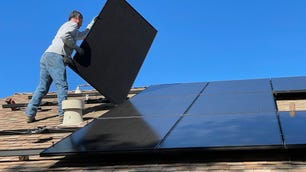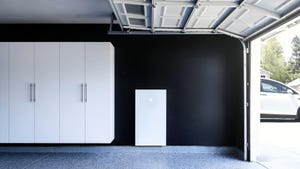Home batteries offer more than just backup power. Here’s how they can save you money.
Home batteries were brought into the world to act as a backup power source for your home, keeping things up and running when the power goes out. But that’s not all they’re good for.
You can also use home batteries to help you save on your electric bills and store energy generated by a solar panel system. The reasons why someone might choose to purchase a battery are actually split pretty evenly. A recent study found that 33% of homeowners who purchase a home battery plan to use it for utility bill savings. Meanwhile, 29% of homeowners plan to use their battery for self-supply purposes and 28% for backup power.
But don’t feel like you have to just pick one reason over another. Most older home battery models placed backup power as the biggest priority, not leaving much room for anything else, and that was fine. But home battery technology has evolved. You can have backup power and bill savings.
These are just a few ways your home battery can help you save money on your power bill.
Cheat time-of-use rates
If your electric utility charges time-of-use rates, a home battery can really help you out. Certain utilities will charge you more for electricity during certain times of the day, sometimes even double what you might normally pay. These are called time-of-use rates. These expensive rates will kick in when the demand for electricity is at its highest, typically during the early morning and evening hours when everyone is at home, more commonly referred to as peak hours
A home battery can help you cheat the system. Instead of paying the utility extra for power during peak hours, you can use the stored energy from your battery to power your home during these hours. You’ll then charge your battery back up when rates go back to normal. This cycle works even better if you have solar panels. Instead of charging your battery with power from the grid, which is power you’re still paying for, you can choose to charge your battery with solar.
The best part is that you don’t even have to worry about trying to remember when to switch to battery power, or even when time-of-use rates come into effect. Most home batteries on today’s market come equipped with special algorithms designed to manage your energy for you. While your installer is setting up your battery, they’ll input your electric utility into the battery’s software. From there, your battery will be able to find your utility’s electric rates and plan out the optimal times to deploy battery power or charge up — just set it and forget it.

Considering Solar Panels?
Our email course will walk you through how to go solar
Pair your battery with solar panels
Solar panels and home batteries are practically a match made in heaven. Your solar panels will generate electricity, while your battery stores it to use for later. This is especially helpful on days when your solar panel system is generating more power than what your home needs. Instead of letting it go to waste, you can send all that excess power to a battery to use when you need it.
And that stored energy can be used for all sorts of situations. The first thing that comes to mind is likely backup power, which is always nice to have during unexpected grid outages. But you can also use your stored solar energy to power your home with solar at night, or use it to cheat time-of-use rates.
A home battery is especially helpful to have on hand in certain states where net metering policies are less than favorable. Net metering is the process of selling your excess solar energy to the utility by back feeding it to the power grid. The amount you’ll be compensated all depends on the net metering laws in the area. Home batteries tend to be more popular in states like California, Georgia, Hawaii and Tennessee, which are all states where you’ll be compensated less for any excess solar energy you sell to the utility than you would pay for electricity from the grid.
Join a virtual power plant
Virtual power plants (VPP) are another way you can use home batteries to lower your electric bills, and even lower the purchase price of the battery itself. By enrolling your battery in a VPP, it’ll be one of many batteries to be called upon to help support the power grid. VPPs are essentially swarms of large batteries that are managed and operated by a local electric utility to help control electricity demand. When the grid is experiencing extreme demand, the utility will discharge stored energy from the batteries to send to the power grid. These batteries can also help control the opposite issue — when there’s too much electricity being sent to the grid (typically from solar), the batteries will charge up via grid power, relieving some of the stress on the grid.
But the best part about participating in a VPP is that you’ll be compensated for doing so, and you don’t even have to do anything. Instead of having full ownership of your home battery, you’ll share that ownership with the utility company in exchange for the use of your battery. With just a few pushes of a button, the utility will charge and discharge your battery as it deems necessary. And you’ll be compensated all the while.
As an incentive to join VPPs, utilities will often offer to pay for a portion of your home battery in exchange for your participation. So if paying full price for a home battery isn’t in the budget and you don’t mind sharing, joining a VPP might be worth it. Contact your local utility to see if they offer any VPP programs.
You can still have backup power
No matter what you choose to use your home battery for, backup power will still remain as one of its primary functionalities, and that’s not going away anytime soon. If you choose to join a VPP or use your battery for utility bill savings, you can still do that too.
You can portion out your battery’s energy storage capacity to reserve it for certain functions. For instance, you might reserve 30% of your battery’s capacity for backup power and then use the rest of its capacity for powering your home during peak hours.
If your battery is enrolled in a VPP program, then you’ll have less freedom on how much capacity you want to reserve for backup power. This is because you share ownership of the battery with the utility. However, most utilities will usually let you reserve up to at least 20% of the battery’s capacity for backup power. The rest will be managed by the power company. If you’re interested in joining a VPP, contact your local utility or local installers in your area.
Best Solar Products and Companies
Solar Installers by State
Solar Installers & Storage
Solar Resources and Guides
Living Off the Grid Series
Article updated on November 7, 2024 at 5:33 PM PST
Our Experts

CNET staff — not advertisers, partners or business interests — determine how we review the products and services we cover. If you buy through our links, we may get paid.
We thoroughly evaluate each company and product we review and ensure our stories meet our high editorial standards.















